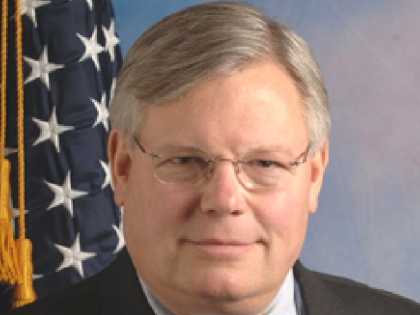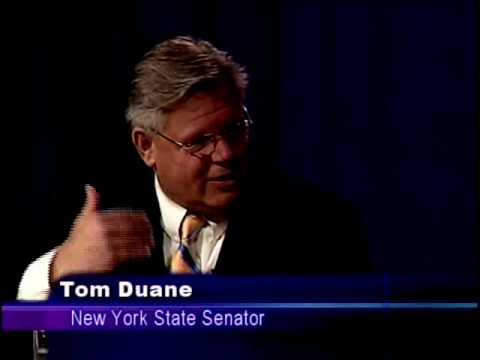
NYS Senator Duane's Testimony Before the New York City Planning Commission Regarding Riverside Center
Thomas K. Duane
September 18, 2010
September 15, 2010
My name is Thomas K. Duane and I represent New York State's 29th Senate District, which includes the Riverside Center project site and the surrounding neighborhood. Thank you for the opportunity to testify regarding Extell Development Company's (Extell) proposal.
The Riverside Center development, which will occupy Riverside South's final parcels from West 59th to West 61st Streets between West End Avenue and Riverside Boulevard, presents an exciting opportunity for Manhattan's Upper West Side. The project will transform a site that currently serves as a parking lot—and that is one of the last large-scale waterfront soft spots in the area—into an extension of the surrounding residential and commercial neighborhood with an urgently-needed public school and hundreds of affordable housing units. I also appreciate that this project will create thousands of temporary and permanent jobs, as local unemployment has approximately doubled in recent years.
I want to express my gratitude to the New York City Department of City Planning (DCP), the New York City Department of Housing, Preservation & Development (HPD) and the New York City School Construction Authority (SCA) for their commitment to working with the community throughout the Uniform Land Use Review Procedure (ULURP), and also to Extell for its active and open engagement with Manhattan Community Board 7 (CB7). I also applaud CB7 for its thoughtful and persuasive July 2010 Report and Resolution on this proposal.
As CB7 notes, the current proposal not only fails to mitigate some of the most troubling negative impacts identified in the project’s Draft Supplemental Environmental Impact Statement (DSEIS), but it also fails to remedy the existing Riverside South development's enduring adverse impacts. Furthermore, certain aspects of the proposal violate the community's Core Principles as expressed by CB7 and must be modified accordingly.
Perhaps Riverside South's most salient negative impact is school overcrowding. For many years, Upper West Side families have endured the persistent and systemic overcrowding of our public schools. The past decade’s development boom—particularly the large residential buildings in Riverside South that have already been occupied—has brought unprecedented numbers of new school-age children into the area, yet there has been no commensurate increase in school seats. The failure to date of the SCA to work with the many developers who have capitalized on the area's excellent public schools to create more school space has created an unsustainable rise in local school utilization rates.
The Riverside Center DSEIS finds that Extell's proposed 75,000 square foot (SF) school would leave the area with a shortfall of 555 seats, forcing nearby public schools to operate at 140 percent utilization. I strongly urge Extell to provide at its own expense a 151,598 SF school that meets the specifications articulated in CB7’s Report and Resolution, and to locate it in the first building to be built on the site. Extell's present offer to fund the construction of the core and shell of a school half that size would only serve as many students as are projected to come into the development and does nothing to relieve overcrowding in other community schools. Furthermore, it relies upon SCA to build out the space in order for it to be usable—an uncertainty in this economic climate. This is totally unacceptable.
Unmitigated negative impacts specific to Riverside Center are largely related to the proposed density of the project. While the 1992 restrictive declaration for Riverside South permits 2,372,192 SF of development on these parcels, Extell seeks to build 3,014,829 SF. The proposed configuration of buildings relegates much of the site’s open space to narrow, unusable and inaccessible strips along building perimeters; casts shadows on the rest of the open space through the fall, winter, and part of the spring; and sets this space apart in such a way that, depending on the site's retail uses and other elements, would likely discourage use of the site by the general public. Furthermore, the DSEIS finds that increased demand on insufficient active open space in the surrounding area is an unmitigated impact of the project. I echo CB7's recommendation in its Report and Resolution that Extell remove Building 4 (mid-block on West 59th Street), fill in its footprint with active public open space, and further reduce the development's total floor area to that which is permitted in the existing restrictive declaration.
I also urge Extell to heed CB7’s other recommendations for modifying its site plan, including extending West 60th Street to Riverside Boulevard, bringing the entire site to grade and surrounding the open space with public streets or broad pathways. These modifications would improve the circulation of the site, contextualize the entire development and render it more inviting to the general public. Building lobbies would open onto public streets and the open space would be clearly separated from the narrow lawns that serve as building setbacks.
As an elected official representing a district with one of the most cost-prohibitive housing markets in the nation, I am also particularly concerned about the provision of affordable housing. Extell proposes to provide 20 percent of the total residential floor area as affordable housing through the City's Inclusionary Housing Program. I share CB7's position that this development should not be permitted to proceed unless the application is modified to include 30 percent mixed-income permanently affordable housing, primarily integrated in the site. Many recent large-scale land use actions have demonstrated the viability of roughly this proportion of affordable housing, including the redevelopment of the Domino Sugar Factory and the rezonings of Hudson Yards and West Chelsea.
Additionally, while I would hope that Extell also shares the belief so beautifully expressed by CB7 that "the social good generated by including affordable units is best achieved when affordable units are integrated among market-rate units," I was troubled to learn that the company is considering providing separate entrances for residents of affordable and market-rate units. Such segregation is unseemly, outdated and abhorrent, and the City of New York must not tolerate it.
I also urge the New York City Planning Commission (CPC) to require the developer to adhere to the principles of PlaNYC 2030 and to secure the highest possible Leadership in Energy and Environmental Design certification. This long-planned development should serve as a model for green building and sustainable development, maximize energy and water use efficiency and promote good environmental stewardship among its residents. For example, CB7 has recommended the inclusion of a below-grade car sharing facility, plug-in connections for electric cars, on-site clean energy sources, and an energy management system. The developer should also consider allotting space for an urban and/or rooftop garden that could be integrated into the on-site school’s curriculum.
I strongly agree with CB7 that, in the interest of sustainability as well as the needs of the community, Extell should eliminate the proposed auto showroom and auto repair center and replace them with community-oriented retail or other uses that will attract visitors to the site. This modification would have the added benefit of enabling Extell to eliminate the connecting 30-foot curb cut on West 59th Street that, if heavily trafficked, could pose a danger to the pedestrians and bicyclists who use the street to access Riverside Park South. In general, commercial facilities in Riverside Center—including the sites of the proposed automotive uses—should be designed to accommodate a diverse mix of small businesses that serve the local community.
While Riverside Center has the potential to be a great asset to the Upper West Side and to benefit to the entire community, the current proposal fails to meet this potential. I urge CPC to conditionally disapprove the ULURP applications relating to this development unless the applicant follows the recommendations above. I remain optimistic that Extell will work collaboratively with the community to align the final project with CB7s’s vision, which is reasonable, attainable and will be beneficial for all.
Share this Article or Press Release
Newsroom
Go to NewsroomTom Duane In The Neighborhood on Primary Health Care
January 4, 2010

Important Phone Numbers for 29th NYS Senate District Residents
January 4, 2010
December 2009 Community Report
December 31, 2009